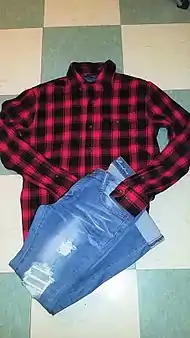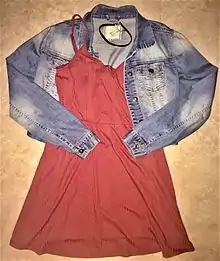Grunge fashion
Grunge fashion is the clothing, accessories and hairstyles of the grunge music genre and subculture which emerged in mid-1980s Seattle, and had reached wide popularity by the early 2000s. Grunge fashion is characterized by durable and timeless thrift-store clothing, often worn in a loose, androgynous manner to de-emphasize the silhouette. The style was popularized by music bands Nirvana, Soundgarden and Pearl Jam.

Origins
The term grunge was adopted by the music industry for a style of music that had become wildly popular in the American northwest during the early 1990s.[1] The term first appeared in 1972, but it did not become a popular term in widespread media until the late 1980s, influenced by the surge and decline of punk.[2] This view made its mark on the youth of the time and translated into their choice of fashion. "Punk is anti-fashion, it makes a statement, while grunge is about not making a statement, which is why it's crazy for it to become a fashion statement." Details editor James Truman said.[3] Therefore, grunge look is different from the punk look. Punk musicians usually wear leather jacket, ripped jeans, shirt without sleeves, metal chains, and dark clothes. In contrast, grunge rockers in Seattle wore mundane everyday clothing to everywhere. For example, Kurt Cobain, singer-guitarist of Nirvana, would simply wear an oversized striped sweater, ripped jeans, a pair of Converse, and an unkempt hair to perform. This low-key style from the Pacific Northwest became popular as grunge entered the mainstream.[4] In an 1998 article for the Journal of Cultural Geography, Thomas Bell said "Flannel shirts and Doc Martens boots were worn as an anti-fashion statement that is undoubtedly related to the unassuming and unvarnished nature of the music itself".[5]
Pop-culture influence on 90s grunge
One of the biggest influences on grunge fashion was rock star Kurt Cobain, the lead singer of the hugely successful band Nirvana. It is widely believed that Cobain represents the core of the grunge movement and the phenomenon of the grunge scene's influence. Cobain's style was a combination from both male and female fashion, and "his Seattle thrift-store look ran the gamut of masculine lumberjack workwear and 40s-by-way-of-70s feminine dresses."[6] Cobain's wife, Courtney Love, was mostly known for her "kinderwhore" sense of style which was used by many female grunge bands. The look consisted of barrettes, tiaras, ripped tights, Mary Janes, slips and Peter Pan collared dresses. Love claims that she drew the inspiration for her kinderwhore look from Christina Amphlett of Divinyls.[7] Pearl Jam made their mark on the grunge fashion scene with leather jackets, corduroy jackets, kilts, shorts-over-leggings, ripped jeans and snapbacks. They were best known for inspiring the Doc Martens trend.[8]

Men's fashion
Grunge fashion was influenced by disheveled and androgynous thrift-store clothing, defined by a looseness that de-emphasized the body's silhouette. Men wore second-hand or shabby T-shirts with slogans, band logos, etc. A plaid shirt would accompany the T-shirt, along with ripped or faded jeans.[9] Black combat-style boots, such as Doc Martens, would complete the ensemble.[10] In 1992, The New York Times wrote: "This stuff is cheap, it's durable, and it's kind of timeless. It also runs against the grain of the whole flashy aesthetic that existed in the 80's."[11] As for hairstyles, men followed the "hair-sweat-and-guitars look"[11] of Kurt Cobain.
Women's fashion
In the 1990s, less was more and dressing-down was an acceptable norm.[12] For shoes, women started wearing clunky combat boots and Doc Martens. They typically wore slip dresses with flannels, flannels and ripped jeans, and plaid in layers. Low-rise and ripped, wide-legged jeans were popular. The clothing was paired with simple jewelry such as chokers and hoop earrings and dark, rich-colored lipstick.[13] Bell-bottom jeans from the 1970s were popular again by 1995, along with the baby-doll T-shirt.[14] When flannels were worn, they were oversized and when it became too hot to wear them, they were tied around the waist.[15] Hairstyles included the half-up-half-down style and messy hair that made the impression nothing was done to it.[13]
Designer
When grunge started to be a popular trend in the early 1990s, fashion designer Marc Jacobs was the first designer who brought grunge to the luxury platform. In 1993, Jacobs as the creative director of women's design at Perry Ellis, debuted a spring collection that was inspired by grunge. The collection included some iconic grunge items such as flannel shirts, printed granny dresses, Dr. Martens boots, and knitted skullcaps. Fashion critic Suzy Menkes declared "Grunge is ghastly." New York magazine said, "Grunge: 1992–1993, R.I.P."[16] A few years later, Jacobs and his business partner joined the French luxury brand Louis Vuitton in 1997.[17]
Grunge in the 2010s

According to a 2013 Today article, the 1990s made a comeback after New York Fashion Week (NYFW) when designers shared their interpretations of Seattle's early 1990s boho-chic. This led to grunge fashion appearing in shopping malls and grunge-inspired back-to-school looks.[18]
In 2013, Yves Saint Laurent and Dries van Noten were trying to bring grunge back to the runway and made it a trend again.[19][20] Yves Saint Laurent's collection was more youthful and streetwear-like, while Dries van Noten's collection was more mature and formal. Yet, these collections were a ready-to-wear collection. They both used some indelible grunge features such as plaid and floral prints, sloppy cardigan, slip dress and oversized silhouette.
References
- "Grunge." Dictionary.com. Dictionary.com, n.d. Web. 21 April 2017.
- "Carla Vadan: Grunge's Influence on Fashion". Carla Vadan. Archived from the original on 19 May 2017. Retrieved 17 April 2017.
- Maureen., Callahan. Champagne supernovas : Kate Moss, Marc Jacobs, Alexander McQueen, and the '90s renegades who remade fashion (First Touchstone hardcover ed.). New York. ISBN 1451640587. OCLC 852226384.
- Steven, Felix-Jager (2017). With God on our side towards a transformational theology of rock and roll. Eugene, OR: Wipf & Stock. ISBN 978-1498231794. OCLC 973764580.
- Bell, Thomas (1998). "Why Seattle? An Examination of an Alternative Rock Culture Hearth". Journal of Cultural Geography. 18 (1): 40. doi:10.1080/08873639809478311.
- Nnadi, Chioma. "Why Kurt Cobain Was One of the Most Influential Style Icons of Our Times". Vogue. Retrieved 21 April 2017.
- Garis, Mary Grace (9 July 2014). "The Evolution of Courtney Love". Elle. Retrieved 21 April 2017.
- Harris, James. "11 Ways '90s Grunge Influenced StreetwearPearl Jam vs. A$AP Mob". Complex. Retrieved 21 April 2017.
- "Grunge Fashion: The History Of Grunge & 90s Fashion". RebelsMarket Blog. Retrieved 17 April 2017.
- "Grunge's Influence on Fashion". LoveToKnow. Retrieved 17 April 2017.
- Marin, Rick (15 November 1992). "Grunge: A Success Story". The New York Times. ISSN 0362-4331. Retrieved 24 April 2017.
- Thomas, Pauline. "The 1990s Fashion History Part 1". www.fashion-era.com. Retrieved 21 April 2017.
- Brewer, Taylah (31 March 2016). "The 90s Fashion Trend That is Making a Comeback". Fashion Trends and Style Blog. Retrieved 21 April 2017.
- "American Fashion Through the Decades | InterExchange". InterExchange. Retrieved 21 April 2017.
- Brooke, Taryn. "Wall St. Cheat Sheet: 6 of the Best Fashion Trends from the 1990s". ProQuest 1759274405. Cite journal requires
|journal=(help) - "Grunge: 1992–1993 R.I.P.". New York. March 1993. p. 24.
- Phelps, Nicole. "Perry Ellis Spring 1993 Ready-to-Wear Fashion Show". Vogue. Retrieved 9 October 2017.
- Vivinetto, Gina (23 August 2013). "Return of 'Teen Spirit'? Grunge Is Back in Fashion (and That's Not a Bad Thing)". Today. Retrieved 14 October 2020.
- Blanks, Tim. "Saint Laurent Fall 2013 Ready-to-Wear Fashion Show". Vogue. Retrieved 9 October 2017.
- Blanks, Tim. "Dries Van Noten Spring 2013 Ready-to-Wear Fashion Show". Vogue. Retrieved 9 October 2017.